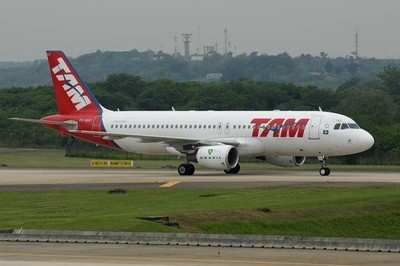Sun, Nov 28, 2010
Fourty-Five Minute Biofuel Flight First For The Region
The biofuel bandwagon has crossed over into Latin America. TAM
Airlines and Airbus have conducted the first Jatropha-based biofuel
flight in Latin America, using an Airbus A320. The biofuel,
processed by Honeywell subsidiary UOP LLC was a 50 percent blend of
locally-sourced Brazilian Japtropha-based bio-kerosene and
conventional aviation kerosene. 20 people from TAM Airlines and
Airbus were on board the A320 powered by CFM56 engines which took
off from Galeao Antonio Carlos Jobim International airport in Rio
de Janeiro, where it returned after a 45 minute flight.

"Airbus and TAM have taken an important step towards
establishing an aviation biofuel solution that is both commercially
viable and sustainable, with positive impact on the environment,"
said Airbus' President and CEO, Tom Enders. "This flight serves as
evidence of the aviation industry's commitment to advance on its
self-imposed CO2 reduction targets: carbon neutral growth from
2020, and working towards a 50 percent net CO2 reduction by
2050."
"This experimental flight materializes TAM's participation in a
vast project to develop a production chain for renewable biofuel,
with the purpose of creating a Brazilian platform for sustainable
aviation bio-kerosene," said Libano Barroso, president of TAM
Airlines.
Studies show that the use of biofuels made from Jatropha in
aviation could reduce the sector's overall carbon footprint by up
to 80 percent, compared with conventional petroleum-based aviation
kerosene. TAM Airlines and Airbus both support the study and
assessment of the sustainability and economic viability of
implementing the bio-kerosene value chain in Brazil.
The technical flight was approved by Airbus, the engine provider
CFM International, and was authorized by aviation authorities in
Europe (the European Aviation Safety Agency - EASA), and Brazil
(National Civil Aviation Agency - ANAC).
"TAM's young and modern Airbus fleet has one of the lowest
carbon footprints in the region, leading the way for the rest of
the industry to contribute to the cause," Enders added.
More News
Airport Marking Aids Markings used on runway and taxiway surfaces to identify a specific runway, a runway threshold, a centerline, a hold line, etc. A runway should be marked in ac>[...]
"It is extremely difficult, if not impossible, for manned aircraft to see a drone while conducting crop-enhancing and other aerial applications at low altitudes and high speeds. We>[...]
Aero Linx: The Skyhawk Association The Skyhawk Association is a non-profit organization founded by former Skyhawk Pilots which is open to anyone with an affinity for the A-4 Skyhaw>[...]
“The T-54A benefits from an active Beechcraft King Air assembly line in Wichita, Kansas, where all required METS avionics and interior modifications are installed on the line>[...]
Aero Linx: Aerostar Owners Association The Association offers the Aerostar Owner a unique opportunity to tap an invaluable source of information concerning the care and feeding of >[...]
 ANN's Daily Aero-Term (04.28.24): Airport Marking Aids
ANN's Daily Aero-Term (04.28.24): Airport Marking Aids Aero-News: Quote of the Day (04.28.24)
Aero-News: Quote of the Day (04.28.24) ANN's Daily Aero-Linx (04.28.24)
ANN's Daily Aero-Linx (04.28.24) Aero-News: Quote of the Day (04.29.24)
Aero-News: Quote of the Day (04.29.24) ANN's Daily Aero-Linx (04.29.24)
ANN's Daily Aero-Linx (04.29.24)



